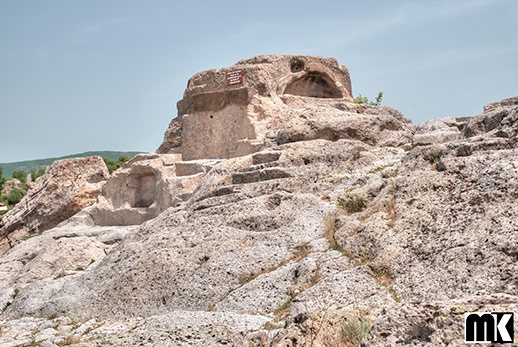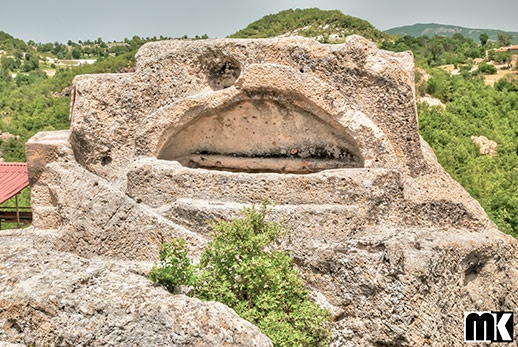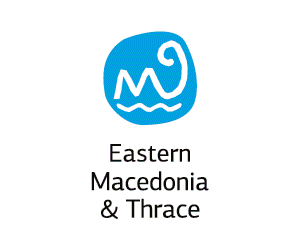Traveler's Guide
East Macedonia & Thrace
Religious complex "Tatul" near the village of Tatul

The exact dating of the megalithic monument is debatable because the excavated materials are from different eras. One hypothesis dates the materials back to 6000 years ago - at the end of the Copper Age, i.e. older than the pyramids. The complex consists of an ancient pagan temple and a medieval fortress. The central and highest place on the rock hill is occupied by a grave with east-west orientation, carved in solid rock like a truncated pyramid. There is a similar rock-hewn tomb on the south side of the majestic rock.It is located in a hemispherical niche.There is a rock-hewn arched vault covering the niche.A rock-hewn eight-step ceremonial staircase leads to the two graves. On the neighboring rock, there are cult platforms with stairs towards them, niches, systems of chutes and pools to collect some liquid. Besides being a sanctuary where sacrifices to ancient Thracian gods were offered, Tatul most certainly was a center for monitoring the sunrise and sunset on certain days of the year such as the winter solstice. For example, the rising sun could be seen from a special rock crevice. This is inferred by the shape of the highest part of the megalith - an engraved crescent resembling a rising sun. The most peculiar thing is that this kind of sarcophagus is directed exactly toward the Sun at the equinox days. The rock in the shape of a truncated pyramid, sheltering the sanctuary, is like no other found in our land. There are rock-hewn steps leading up to the top, where there is a strange "sarcophagus" whose length is 170 cm and around which there is a furrow. Experts assume that the furrow was needed to drain the blood from the placed in the sarcophagus victim. It is known that the Thracians worshiped the sun and the rituals were relevant to that particular cult. So in all likelihood, sacrifices were made at sunrise (or sunset).
One scientific hypothesis is that it is a sanctuary of Orpheus, sometimes even considered to be the burial place of the mythical singer. But there is no basis in historical fact and at this stage of research this cannot be proven. But the fact is that the place described is only a part of a much larger religious complex, which must be studied. North of it, there are other rock-hewn trapezoidal niches and rock tombs. Graves and stone sculptures from different periods were found in the surrounding fields, as well as ancient and medieval inscriptions. There is a statuette of a nude man leaning with one hand on a lyre, with the other holding plektron - something like a feather used for playing music. The statuette is dated to the 2nd - 3rd century i.e. the Roman era and most likely represents Orpheus. There are also over 20 ritual vessels. Among some of the findings, there is a ceramic crozier, a well-preserved clay oil-lamp with beautiful ornaments, a spindle-whorl, pyramid-like weights for a vertical loom, coins from the 4th -3rd century BC from Thassos and Maroneia, parts of the ceramic mask of Dionysus, tiles, the head of a bird, etc..
It is quite certain that just like Perperikon, Tatul maintained complete continuity between pagan cults and Christianity. As long ago as the in the early Bronze Age (4th -7th centuries) a strong fortress was built in the rock.It was later expanded and refurbished many times. Clearly defined is a rectangular tower, whose basement floor served as water storage. There is another that is completely carved into the rock and located 5 meters from the tower. It has the shape of a pear and the inside is coated with a thick layer of mortar. In all likelihood, there was a church during the Middle Ages but now it is completely destroyed. There are also two stone columns and capitals with crosses depicted on them. The medieval settlement itself was located in the field below the fortress and below the modern village, near the river. There are several necropoles of that time whose graves are supported with stone slabs.
According to Greek mythology, Orpheus was the son of the river god Eagar and the poetry muse Calliope. A great poet and singer, Orpheus competed even with the god of music and songs, Apollo. His incredible voice charmed all living creatures and during the march of the Argonauts for the Golden Flute he silenced the dangerous song of the sirens and saved the heroes. Orpheus is often depicted with a guitar or a lyre, out of whose strings he created magical sounds that made forest animals run after him, rocks and mountains move, wild beasts lie down at his feet.
The poet’s love for Eurydice is known from Greek myths. Snakebitten, the beauty dies on the day of their wedding. To save her, Orpheus descends into the underworld god Hades and touched everyone with sad songs. He persuaded the ruler of the souls to return his beloved, but when going back he did not comply with the condition not to look at her while it was still daylight and he lost her forever. This episode is directly connected with the death of Orpheus. He neglected female beauty after the death of his beloved and this is why he was killed by Bacchanal women during mysteries in honor of Dionysus. This event brings to the earlier level of mythodological thinking because It is known for sure that Orpheus is of Thracian origin and played an important role in Thracian religion.It is not accidental that in ancient art Orpheus is always depicted in Thracian clothes and his whole life passes in the land of the Thracians. It seems that in their mythology he was more of a priest and magician, endowed with supernatural power. Modern science believes that the hero has inspired an entire philosophical and religious system which was named Orphism. It is assumed that it occured in Thrace between the end of the second millennium BC and 9th -8th BC. Later the whole doctrine spread in Greece and the Mediterranean world. Supporters of Orphism were even many Roman emperors. This is a purely aristocratic concept based on Dionysian mysteries
In ancient times it was all passed on exclusively by oral epic, which formed the preconditions for the emergence of the Parent-king ; the king providing fertility, the king-priest and anthropodemon, the perfect and immortal king, god of himself and first priest people for his people.
Orphic mysteries were performed only by the initiated, and such were only unmarried men. They were called a-bii (i.e. non-life), because they didn’t lead a normal and ordinary life. Mysteries were held in closed societies and hidden places invisible for the eyes of others (The numerous rocks and caves in the Eastern Rhodope, Strandzha Mountain and Sakar Mountain). They were accompanied by choral songs and mimic games. Culminations represent the symbolic death of the king-priest, identified with the dismemberment of Dionysus by the Titans, and also the symbolic birth of the Mother Goddess, being the source of life. The first is implemented through the blood sacrifice of a bull, horse, goat, and sometimes people. Conception is materialized through a mass intercourse between men and women that made Herodotus accuse the Thracians of sexual promiscuity. Later, Orphic mysteries became the symbol of unbridled Bacchanalia in honor of the god of wine Dionysus and gaiety. But if the cult of Dionysus was primitive, elemental, spontaneous and emotional, the cult of Orpheus was elaborate, developed, controlled, and intellectualistic. Even though both aimed at the same goal, immortality through divinity, Orphism was the cult that fostered an ascetic rule of life that was the exact opposite of Dionysianism.All being said, Orphism represented reformed Dionysianism and developed an elaborate theology of a highly speculative character.
An interesting fact is that from the grave of Orpheus has sprung a vine from the legendary Thracian variety Zelaya, which is considered extinct millennia ago. They called the grapes “Tears of Orpheus." This is all very odd because not only aren’t there vines on the hill, but also within a radius of 10 kilometers.
Address
No information available.Contact Information
No information available.







